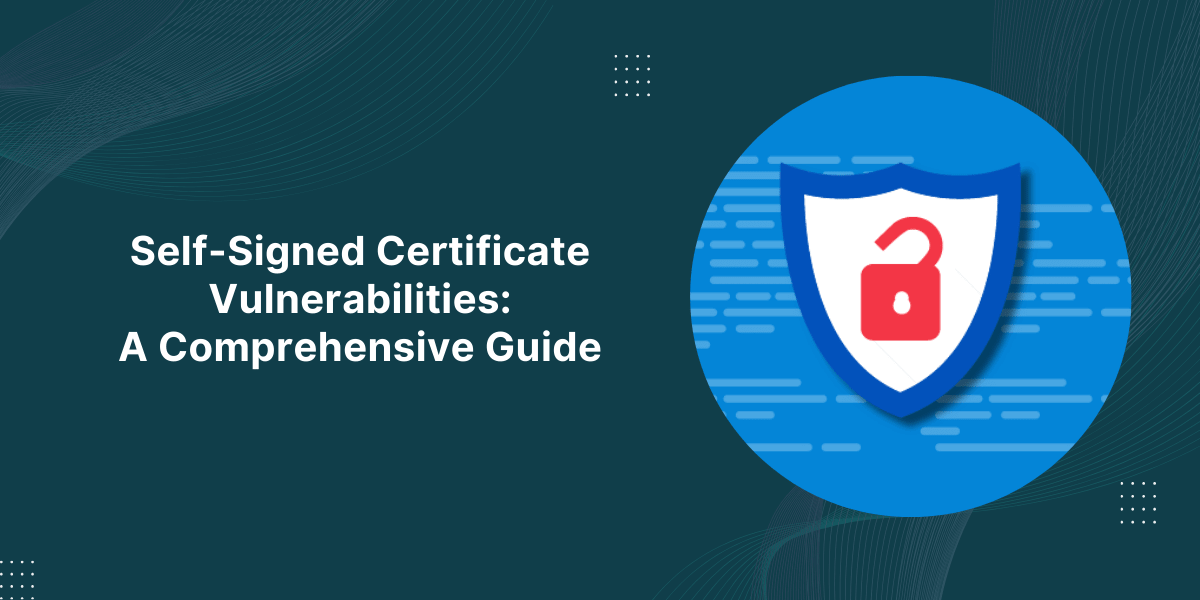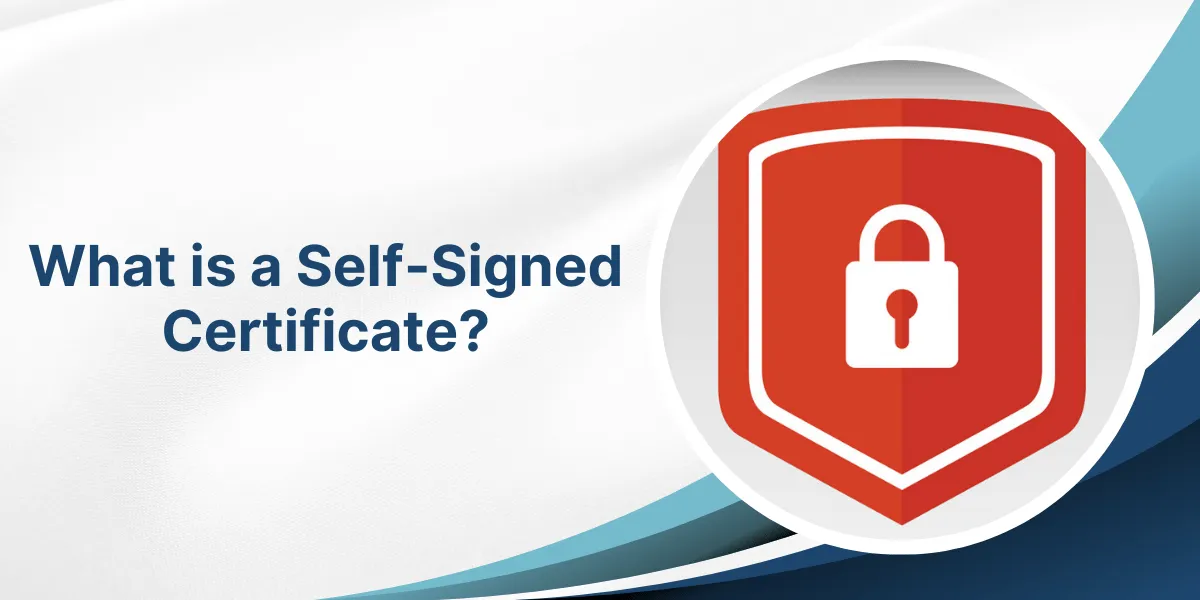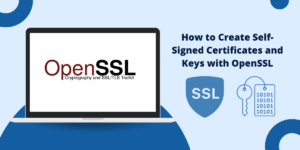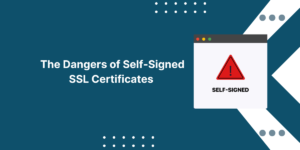Self-signed certificates are digital certificates that are signed by their own creator rather than a trusted certificate authority (CA). While self-signed certificates can be useful in certain situations, such as for testing purposes, they also pose significant security risks if used improperly in production environments. This comprehensive guide examines the Self-Signed Certificate Vulnerabilities and provides best practices for securing systems that utilize them.
What are Self-Signed Certificates?
A self-signed certificate is a digital certificate that is generated and signed by the entity that created it, rather than being signed by a trusted third-party certificate authority.
Self-signed certificates contain the same basic information as certificates signed by a CA, including:
- Public key: The public key used to encrypt communication between the client and server.
- Identity information: Details about the organization or domain, such as common name, locality, country, etc.
- Validity period: Start and end dates indicating when the certificate is valid.
- Signature algorithm: Mathematical technique used by the private key to sign the certificate.
Unlike CA-signed certificates, self-signed certificates are not chained to a trusted root certificate that has been independently verified. As a result, clients cannot easily verify the authenticity of self-signed certificates.
Common Uses of Self-Signed Certificates
Some common uses cases for self-signed certificates include:
- Testing and development: Self-signed certificates are handy for quickly setting up test environments when official certificates are not needed.
- Internal or private networks: Self-signed certificates may be used on private networks or intranets where the organization controls all clients and servers.
- Temporary or short-term deployments: If a system will only be deployed for a limited time, self-signed certificates avoid the cost and time of obtaining a CA-signed certificate.
While useful in controlled environments, the security limitations of self-signed certificates make them risky for public-facing production systems.
Self-Signed Certificate Vulnerabilities and Risks
The primary security risk with using self-signed certificates is that clients have no easy way to validate their authenticity or trustworthiness. This opens the door for man-in-the-middle (MITM) attacks, intercepting sensitive communications.
Lack of Trusted Validation
With CA-signed certificates, the certificate chains up to a trusted root certificate that has been vetted by the CA. Operating systems and browsers contain a store of trusted root certificates from major CAs that they use to automatically validate certificates.
Self-signed certificates are not chained to these trusted roots, so clients have no means to verify their validity. Users will see security warnings about untrusted certificates, but these warnings are often ignored.
Spoofing and MITM Attacks
Because clients cannot distinguish legitimate self-signed certificates from fraudulent ones, it is trivial for attackers to spoof identities with forged self-signed certificates.
Attackers can intercept network traffic and present their own fake self-signed certificate pretending to be the destination server. The user will receive no warnings because the fraudulent certificate appears no different than a valid self-signed certificate.
With this MITM position, attackers can:
- Read and modify any unencrypted data communicated, including sensitive information like passwords and session cookies.
- Impersonate the server identity to deploy malware or extract private data from users.
- Manipulate communications to sabotage or reroute connections.
No Revocation Checking
With CA-signed certificates, CAs maintain Certificate Revocation Lists (CRLs) to revoke compromised or fraudulent certificates. Clients check these lists to ensure the certificate has not been revoked.
Self-signed certificates cannot be revoked, so if one is compromised there is no way for users to know the certificate should no longer be trusted. Attackers can continue using stolen self-signed certificates until they expire.
Best Practices for Self-Signed Certificates
If your organization must utilize self-signed certificates, following security best practices is critical to minimize risks:
Use Only Where Absolutely Necessary
Avoid using self-signed certificates on public-facing production systems if possible. The risks almost always outweigh the benefits for externally accessible sites and applications.
Save self-signed certificates for private networks, testing environments, and temporary or internal systems where you control all clients.
Educate Users on Risks
Alert users to the reduced security of self-signed certificates so they do not blindly trust the connection. Instruct them to pay attention to certificate warnings and report anything suspicious.
Shorten Expiration Periods
Reduce the validity period of self-signed certificate to limit the window of opportunity if they are compromised. 30 days or less is recommended over the 1-2 year periods typical with CA certificates.
Automate Certificate Generation
Automating self-signed certificate generation with scripts or management tools improves rotation and avoids outages as certificates expire.
Create a Private CA
For enterprise internal networks, creating your own private CA provides more security than using pure self-signed certificates. Clients can trust your private CA root, enabling revocation and reducing spoofing risks.
Use Certificate Pinning
Certificate pinning hardcodes certificate details into an application so fraudulent certificates are rejected even if signed by a trusted CA. This helps mitigate attacks on systems using self-signed certs.
Isolate Critical Systems
Where possible, isolate systems relying on self-signed certificates into separate network zones with firewalls and access controls to limit exposure if certificates are compromised.
Monitor for Anomalies
Inspect network traffic and system logs closely for any indicators of MITM attacks or other misuse of self-signed certificates.
By understanding the risks of self-signed certificates and taking appropriate precautions, organizations can more safely utilize them for niche use cases. For critical systems and public-facing sites, however, CA-signed certificates remain the most secure option.
Conclusion on Self-Signed Certificate Vulnerabilities
While self-signed certificates have valid uses in testing and development environments and private networks, they introduce major security vulnerabilities on public production systems. Lack of trusted validation opens the door for MITM attacks, spoofing, unencrypted data exposure, and other breaches.
Organizations that choose to utilize self-signed certificates must take steps to isolate and protect those systems, shorten expiration periods, pin certificates, and diligently monitor for any evidence of tampering. For public sites and applications, the risks almost always outweigh any minor convenience benefits.
By understanding these risks, educating users, and following security best practices, companies can safely incorporate self-signed certificates into their workflows. But for the highest security on business-critical systems, CA-signed certificates from trusted certificate authorities remain the gold standard.
Frequently Asked Questions About Self-Signed Certificate Vulnerabilities
What are some examples of vulnerabilities caused by self-signed certificates?
Some common vulnerabilities introduced by using self-signed certificates include man-in-the-middle attacks, lack of trust validation, identity spoofing, inability to revoke compromised certificates, and lack of encryption for data in transit.
Can self-signed certificates be used securely on internal networks?
Self-signed certificates can be utilized more safely on private internal networks where you control all the clients and servers involved. However, a private CA is still more secure and allows the benefits of revocation checking.
Are there any best practices for using self-signed certificates?
Best practices include minimizing use cases, educating users on risks, automating, and reducing expiration periods, isolating critical systems, pinning certificates, and monitoring closely for any anomalies that could indicate compromised certificates.
What risks are introduced if users ignore browser warnings about self-signed certificates?
If users click through untrusted certificate warnings, attackers can spoof identities and intercept sensitive communications without detection since users will not be alerted to invalid certificates.
Can certificate pinning fully mitigate MITM attacks on self-signed certificates?
Certificate pinning improves security for self-signed certificates by rejecting fraudulent certs but cannot fully prevent MITM attacks in all scenarios. It should be used in combination with other safeguards.
What are the main advantages of private CAs over self-signed certificates?
Private CAs provide centralized management, scalability, revocation checking, and most importantly a trust chain that allows clients to automatically validate certificates without seeing warnings.
When is it acceptable to use self-signed certificates for public-facing sites?
Self-signed certificates should never be used on production public-facing websites or applications where security is important. The risks dramatically outweigh any minor benefits.



